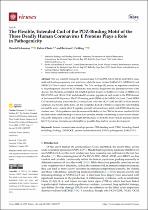The flexible, extended coil of the pdz-binding motif of the three deadly human coronavirus e proteins plays a role in pathogenicity
| dc.contributor.author | Schoeman, Dewald | |
| dc.contributor.author | Cloete, Ruben | |
| dc.contributor.author | Fielding, Burtram C. | |
| dc.date.accessioned | 2022-09-06T10:05:52Z | |
| dc.date.available | 2022-09-06T10:05:52Z | |
| dc.date.issued | 2022 | |
| dc.identifier.citation | Schoeman, D. et al. (2022). The flexible, extended coil of the pdz-binding motif of the three deadly human coronavirus e proteins plays a role in pathogenicity. Viruses, 14(8), 1707. https://doi.org/10.3390/v14081707 | en_US |
| dc.identifier.issn | 1999-4915 | |
| dc.identifier.uri | https://doi.org/10.3390/v14081707 | |
| dc.identifier.uri | http://hdl.handle.net/10566/7816 | |
| dc.description.abstract | The less virulent human (h) coronaviruses (CoVs) 229E, NL63, OC43, and HKU1 cause mild, self-limiting respiratory tract infections, while the more virulent SARS-CoV-1, MERS-CoV, and SARS-CoV-2 have caused severe outbreaks. The CoV envelope (E) protein, an important contributor to the pathogenesis of severe hCoV infections, may provide insight into this disparate severity of the disease. We, therefore, generated full-length E protein models for SARS-CoV-1 and -2, MERS-CoV, HCoV-229E, and HCoV-NL63 and docked C-terminal peptides of each model to the PDZ domain of the human PALS1 protein. The PDZ-binding motif (PBM) of the SARS-CoV-1 and -2 and MERSCoV models adopted a more flexible, extended coil, while the HCoV-229E and HCoV-NL63 models adopted a less flexible alpha helix. | en_US |
| dc.language.iso | en | en_US |
| dc.publisher | MDPI | en_US |
| dc.subject | Human coronaviruses | en_US |
| dc.subject | Covid-19 | en_US |
| dc.subject | SARS-CoV-2 | en_US |
| dc.subject | Protein | en_US |
| dc.subject | Bioscience | en_US |
| dc.title | The flexible, extended coil of the pdz-binding motif of the three deadly human coronavirus e proteins plays a role in pathogenicity | en_US |
| dc.type | Article | en_US |

